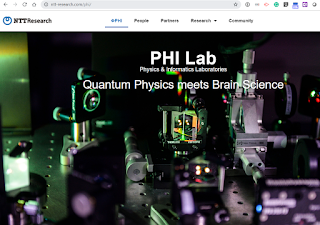NTT Research's Physics and Informatics (PHI) Lab has reached joint research agreements with six universities, one government agency, and one private company.
The PHI Lab, which is focused on a new computing paradigm created in the interdisciplinary field between quantum physics, neuroscience, and optical technology, has struck five-year agreements with California Institute of Technology (Caltech), Cornell University, University of Michigan, Massachusetts Institute of Technology (MIT), NASA Ames Research Center in Silicon Valley, Stanford University, Swinburne University of Technology, and quantum computing software company 1QBit.
“Having launched only four months ago, we are excited to have reached agreements with eight of the world’s top research organizations with interests and expertise in the three fields crucial to our mission: quantum-to-classical crossover physics, neural networks, and optical parametric oscillators,” said NTT Research PHI Lab Director Yamamoto. “Over the next five years, we believe our collaboration will uncover novel principles and technologies that advance information processing beyond the current state of the art.”
“These agreements reflect our belief that a new computing model requires teamwork, in the broadest and best sense of that word,” said Kazuhiro Gomi, President and CEO, NTT Research. “They also represent our respect for the talent and expertise of our primary investigator collaborators and the promise of their research teams.”
Summaries of the eight agreements follow:
- Caltech – Primary goal: to develop a scalable architecture for efficient quantum simulation of many-body systems using optical parametric oscillator (OPO) networks. PI: Alireza Marandi, Assistant Professor of Electrical Engineering and Applied Physics.
- Cornell – Primary goal: to develop a quantum neural network (QNN) based on error detection and error correction feedback. PI: Peter McMahon, Assistant Professor of Applied and Engineering Physics.
- Michigan – Primary goal: to perform theoretical studies of topological states in nonlinear optics and synthetic topological matter. PI: Franco Nori, Affiliated Faculty, Department of Physics.
- MIT – Primary goal: to develop the photonic accelerators for deep learning and the superconducting coherent Ising machines (CIMs) for optimization. PIs: Dirk Englund, Associate Professor of Electrical Engineering and Computer Science; and Will Oliver, Associate Professor of Electrical Engineering and Computer Science and Professor of the Practice of Physics.
- NASA Ames Research Center – Primary goal: to perform benchmark studies of CIMs vs. modern heuristics on various optimization problems. PI: Eleanor Rieffel, Lead, Quantum Artificial Intelligence Laboratory.
- Stanford – Primary goal: to develop novel optical and superconducting devices for studying the quantum-to-classical crossover physics and critical phenomena in the quantum neural network. PI: Hideo Mabuchi, Professor of Applied Physics; and co-PIs: Martin Fejer, Professor of Applied Physics; Benjamin Lev, Associate Professor of Applied Physics and of Physics; Surya Ganguli, Associate Professor of Applied Physics; and Amir Safavi-Naeini, Assistant Professor of Applied Physics.
- Swinburne – Primary goal: to develop and implement the theoretical models for CIMs. PIs: Peter Drummond, Distinguished Professor and Science Director, Centre for Quantum and Optical Science (CQOS); and Margaret Reid, Professor of Physics, School of Science, CQOS, and Department of Physics and Astronomy.
- 1QBit – Primary goal: to perform research in design and analysis of a stack of algorithms that bridge commercially viable applications to the forms of computation natively done by CIMs, with a multitude of applications in operations research and artificial intelligence. PI: Pooya Ronagh, Head of Hardware Innovation
Innovative Optical and Wireless Network Forum launched by NTT










